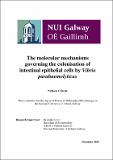| dc.contributor.advisor | Boyd, Aoife | |
| dc.contributor.author | O Boyle, Nicholas | |
| dc.date.accessioned | 2013-07-16T12:24:19Z | |
| dc.date.available | 2015-05-01T10:55:39Z | |
| dc.date.issued | 2012-12-19 | |
| dc.identifier.uri | http://hdl.handle.net/10379/3524 | |
| dc.description.abstract | Vibrio parahaemolyticus is a food borne gastro-intestinal pathogen of major global importance. The organism induces severe inflammatory diarrhea in individuals who become infected due to the consumption of contaminated seafood. V. parahaemolyticus is known to exert pathogenic effects upon host cells by the translocation of effector proteins into the host cell, using a type three secretion injectisome, however little is known about the molecular interactions which allow colonisation and persistence of the organism in the intestinal epithelium. This study analysed the adherence and invasion of V. parahaemolyticus using the established intestinal cell line Caco-2. V. parahaemolyticus was found to adhere at high levels to Caco-2 cells. A small number of the adherent bacteria became internalised and were subsequently capable of intracellular proliferation. A genomic library based approach was undertaken in order to identify novel proteins conferring adhesive and invasive traits (adhesins/invasins) upon V. parahaemolyticus. Bioinformatic mining was also carried out in order to identify putative adhesins/invasins based on amino acid identity to characterised adhesins/invasins from other species. One adhesin identified was confirmed as having a role in the adherence of V. parahaemolyticus to intestinal Caco-2. Deletion of essential components of the mannose sensitive haemagglutinin (MSHA) pilus resulted in a 40% decrease in adherence and a similar decrease in uptake by Caco-2. The decreased adhesive properties of MSHA mutants correlated with significant decreases in V. parahaemolyticus induced lysis, cell rounding and IL-8 induction in Caco-2. Neoglycoconjugate array comparison between the V. parahaemolyticus wild type and MSHA deficient mutants identified lectin functionality for the MSHA pilus with specificity towards the fucosylated blood group antigens. This study highlighted key aspects of the colonisation of intestinal tissues by V. parahaemolyticus. The findings discussed herein alter the currently recognised molecular mechanisms of intestinal colonisation by V. parahaemolyticus and have implications for the pathobiology of numerous enteric pathogens. The techniques and observations of this study may be applied to the analysis of other intestinal pathogens, with a view to understanding the processes which occur during initial interactions with host cells and eventual development of therapeutics to prevent colonisation and the subsequent onset of disease. | en_US |
| dc.rights | Attribution-NonCommercial-NoDerivs 3.0 Ireland | |
| dc.rights.uri | https://creativecommons.org/licenses/by-nc-nd/3.0/ie/ | |
| dc.subject | Vibrio parahaemolyticus, colonisation, adherence, invasion, survival, proliferation, Caco-2, lectin | en_US |
| dc.subject | Vibrio parahaemolyticus | en_US |
| dc.subject | Colonisation | en_US |
| dc.subject | Adherence | en_US |
| dc.subject | Invasion | en_US |
| dc.subject | Survival | en_US |
| dc.subject | Proliferation | en_US |
| dc.subject | Caco-2 | en_US |
| dc.subject | Lectin | en_US |
| dc.subject | Microbiology | en_US |
| dc.title | The molecular mechanisms governing the colonisation of intestinal epithelial cells by Vibrio parahaemolyticus | en_US |
| dc.type | Thesis | en_US |
| dc.contributor.funder | Science Foundation Ireland | en_US |
| dc.local.note | This study involved an investigation into surface expressed proteins which confer adhesive and invasive characteristics on the shellfish borne pathogen Vibrio parahaemolyticus. Cultured intestinal cells and genomic library based selection methods were employed in order to identify novel proteins involved in adherence, invasion and downstream virulence against intestinal cells | en_US |
| dc.local.final | Yes | en_US |
| nui.item.downloads | 818 | |


